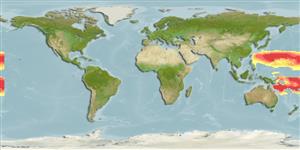Actinopterygii (Straalvinnigen) >
Stomiiformes (Lightfishes and dragonfishes) >
Stomiidae (Barbeled dragonfishes) > Melanostomiinae
Etymology: Eustomias: Greek, eu = good + Greek, stoma = mouth (Ref. 45335).
Omgeving / Klimaat / Range
Ecologie
; marien bathypelagisch; diepteverspreiding 0 - 415 m (Ref. 11333). Deep-water, preferred ?
Western Central Pacific: Queensland, Australia.
Size / Gewicht / Leeftijd
Maturity: Lm ? range ? - ? cm
Max length : 15.8 cm SL mannelijk/geslacht niet bekend; (Ref. 11333); 9.7 cm SL (female)
Korte beschrijving
Morfologie | Morfometrie
A single, ovoid terminal bulb 1-1.2% SL. Barbel length short to intermediate 32-60% SL. Short terminal filaments 9 or more of various sizes; shortest filaments often bulblet-tipped; longer ones with bulblets and inclusions of various sizes and shapes; 1 filament thicker and longer than others, not forked, with 1 or more long inclusions filling most of its distal end. Axis of stem lightly or not pigmented. A dark spot usually at the base of the bulb. External chevron-shaped or roundish striated areas unpigmented. Middorsal paired spots between occiput and dorsal-fin origin 7 (Ref. 11333).
Life cycle and mating behavior
Geslachtsrijpheid | Voortplanting | Kuitschieten | Eieren | Fecundity | Larven
Paxton, J.R., D.F. Hoese, G.R. Allen and J.E. Hanley, 1989. Pisces. Petromyzontidae to Carangidae. Zoological Catalogue of Australia, Vol. 7. Australian Government Publishing Service, Canberra, 665 p. (Ref. 7300)
Status op de Rode Lijst van het IUCN (Ref. 115185)
CITES (Ref. 94142)
Not Evaluated
Gevaarlijk voor mensen
Harmless
Gebruik door de mens
Meer informatie
Populaire namenSynoniemenMetabolismePredatorsEcotoxicologieVoortplantingGeslachtsrijpheidKuitschietenFecundityEierenOntwikkeling van de eieren
Leeftijd/GrootteGroeiLengte-gewicht parametersLengte-lengte parametersLengtefrequentiesMorfometrieMorfologieLarvenPopulatiedynamica van de larvenrecruteringAbundantie
ReferentiesAquacultuurAquacultuurprofielKweeklijnenGeneticaAlleelfrequentiesErfelijkheidZiektenVerwerkingMass conversion
Tools
Speciale rapporten
Download XML
Internet-bronnen
Estimates of some properties based on models
Phylogenetic diversity index (Ref.
82805): PD
50 = 0.5000 [Uniqueness, from 0.5 = low to 2.0 = high].
Bayesian length-weight: a=0.00389 (0.00180 - 0.00842), b=3.12 (2.94 - 3.30), in cm Total Length, based on all LWR estimates for this body shape (Ref.
93245).
Trophic Level (Ref.
69278): 4.3 ±0.8 se; Based on size and trophs of closest relatives
Weerstandsvermogen (Ref.
69278): Gemiddeld, minimale populatieverdubbelingstijd 1,4-4,4 jaar (Assuming tmax>3).
Kwetsbaarheid (Ref.
59153): Low to moderate vulnerability (26 of 100) .
